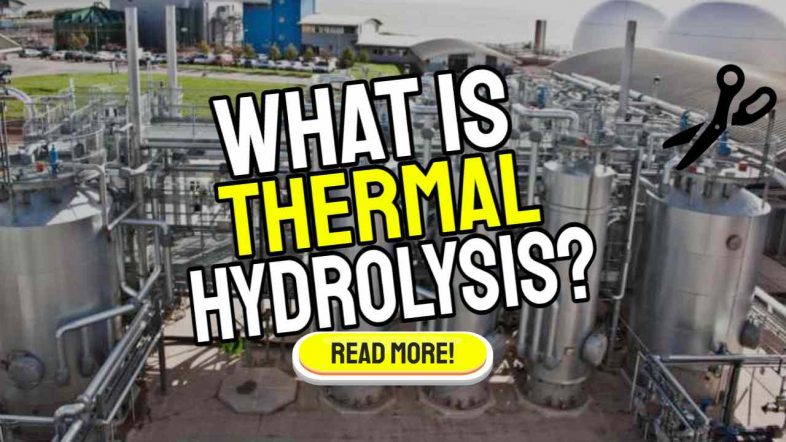So you want to know; “What is the thermal hydrolysis process?” – and to understand basic thermal hydrolysis technology.
Key Takeaways
- Thermal Hydrolysis Process (TH): A chemical process using heat and pressure to break down organic materials in anaerobic digestion (AD) systems. It significantly enhances biodegradability, increases biogas production, and facilitates sludge digestion.
- Biogas and Sludge Benefits: TH increases biogas yields by making more organic matter available for methanogenic organisms. It also improves the dewaterability of sludge, making post-digestion processing more efficient.
- Pathogen-Free Output: TH eliminates pathogens in the sludge, producing a sterilized, pathogen-free fertilizer that meets international regulatory standards, such as the EU Animal By-Products Regulation.
- Enhanced AD Performance: TH doubles the solids loading rate in AD reactors, reduces viscosity, and stabilizes plant operations, making the process more efficient.
- Wider Applications: TH is not limited to large wastewater treatment plants. New low-temperature systems, such as those from Lystek, offer scalable solutions for smaller plants, allowing broader use across various sectors.
- Industry Adoption: Companies like Cambi and Exelys are pioneers in promoting TH technology for AD plants, with multiple installations worldwide since the 1990s.
Definition

Thermal Hydrolysis is a chemical process in which the organic molecules (in the substrate/ feed material) are split into two parts by adding a molecule of water.
The process forces the water molecules between the chemical bonds holding together large tissue molecules such as fats, DNA and proteins.
As the name suggests thermal hydrolysis (TH) uses heat and high pressure to break the cellular tissues down to their original smaller molecular components. This also dramatically reduces viscosity, destroys all infectious agents, and above all it hugely increases biodegradability during fermentation.
Using TH as a feedstock pre-treatment stage before anaerobic digestion considerably increases the biological degradation of organic volatile solids and biogas production.
It makes the sludge readily available for digestion by dissolving and decomposing the sludge solids. It also makes the separation of the solid and liquid phases after digestion easier.
We hope that you like our “What is Thermal Hydrolysis” video below. We looked to see whether anyone had created one to explain the answer to the question. No one had, so we made our own video… You can watch it below:

Up to twice the reactor throughput can be achieved compared with an AD plant without it. Thermal bio-solids hydrolysis is a proven technology and is recognized as being one of the most effective ways to enhance biogas production and solids destruction in anaerobic digestion systems.
Benefits of Thermal Hydrolysis
The benefits of hydrolysis as carried out prior to anaerobic digestion can be listed as:
- The disintegration of the cell structure of organic materials creates smaller molecules that dissolve
- The naturally occurring cell polymers which result provide a form of protein, which is easily digestible during anaerobic digestion
- The lower viscosity (more free-flowing) sludge allows for easier pumping and digester tank mixing with up to double the normal digester dry solids loading
- The fermentation organisms are less stressed, which leads to more stable plant operations.
- The availability of so much more of the organic matter to the methanogenic organisms increases substrate (sludge, bio-waste etc) biodegradability and therefore yields more biogas
- Separation of liquid and solid portions of the digestate occurs more readily, with dewatering achievable up to 40% of total dry solids
- The high pressure and temperature of hydrolysis produce a pathogen-free fertilizer, by holding the material at 165° C for 20 minutes
- Hydrolysation conditions meet and exceed all known national and international standards and requirements for sterilisation, including EU Animal By-Products Regulation (ABPR, 1774/2002/EC) category II & III materials.
Potential for Thermal Hydrolysis as a Part of AD Systems
There is a huge potential for the introduction of thermal hydrolysis of municipal waste solids. Incorporating thermal hydrolysis in new AD Plants, and retrofitting it to existing plants. For example, it represents an opportunity for Wastewater Treatment Works operators to increase the rate of solid hydrolysis, increase the extent of volatile solids reduction, and boost biogas production. At the same time, the more complete reaction achieved brings benefits to the digestate as a fertilizer. There is an increase in nitrogen (N) and phosphorus (P) solubilization enhancing the availability of these essential components of any fertilizer.
Companies Offering TH Process Equipment
Cambi has long been well-known for their Thermal Hydrolysis Sludge Pre-treatment Technology for enhanced Anaerobic Digestion of municipal and industrial sludges. Cambi has been installing thermal hydrolysis as a pre-treatment to anaerobic digestion, around the world since 1995.
However, there now seems to be a trickle-down effect for thermal hydrolysis as a pre-treatment to anaerobic digestion, to be used for smaller biogas plants, and a greater range of feed materials/ substrates.
Exelys is another company actively promoting this technology, which has a TH technology that they describe as representing the next generation of bio-solids thermal hydrolysis. But, these example companies are far from being alone in having spotted a business opportunity in TH within AD Plant Systems.
Many companies not previously active in the AD and Biogas scene, are now also marketing their own TH equipment from their previous experience of this technology from parallel applications in other closely related business sectors.
Low-Temperature Thermal Hydrolysis Biosolids Technology
Lystek’s proven, low-temperature, Thermal Hydrolysis Process is now available and is said to be a cost-effective, easy-to-operate, biosolids and organics management.
Implementing a Lystek THP solution will transform your traditional Wastewater Treatment Plant (WWTP) into a true Wastewater Resource Recovery Center (WRRC) by harnessing and maximizing the value in these amazing resources.
Lystek’s Thermal Hydrolysis Process
The low-heat, low-cost Lystek Thermal Hydrolysis system can be installed as an on-site, (pre or post) anaerobic digestion (AD) solution.
It does not interfere with other WWTP procedures, according to the manufacturer. Microbial cell walls are physically disintegrated, and complicated macromolecules are hydrolyzed into simpler chemicals, thanks to this proprietary technique.
When digested biosolids are added into AD and biological nutrient removal (BNR) systems, the residual volatile solids are more susceptible to further biodegradation.
This results in the production of more biogas faster (i.e. a better biogas yield).
What is Thermal Hydrolysis? It's The Missing Ingredient for Better Biosolids!
Thermal hydrolysis [as used by United Utilities at the Davyhulme and Cardiff WWTWs, for example] is a two-stage process that combines pressure cooking and quick decompression. This combination of actions sterilises the sludge and makes it far more biodegradable, allowing for better digestion. Because sterilisation kills microorganisms in the sludge, it meets or exceeds the strictest requirements for land application.
Furthermore, heat treatment alters the rheology to the point that loading rates into municipal sewage sludge anaerobic digesters can be as much as doubled.
The resulting sludge's dewaterability is also much enhanced.
Cambi delivered the first full-scale use of this technique for sewage sludge to the city of Hias in Norway. Since then, more than 30 additional installations have been made around the world [by 2014].
The implementation of United Utilities' sludge strategy, which was unveiled in 2009, relied heavily on thermal hydrolysis. Depending on changing present and future factors and legislation, the plan was designed to provide maximum flexibility by allowing a combination of biosolids recycling to land, burning for energy recovery, or both.
Our Answer to “What is TH?” – A Conclusion
So, let's now round off our article on, Thermal Hydrolysis (TH).
Thermal hydrolysis as a pre-treatment to anaerobic digestion was at the time of writing (September 2014), very much in the news with the announcement that the UK Water Utility company, United utilities will soon start to use the world's largest TH plant as a pre-treatment stage to their anaerobic digestion plant, at a major UK Wastewater Treatment (Sewage) Works.
Thermal Hydrolysis FAQs
1. What is thermal hydrolysis?
Thermal hydrolysis is a process that uses heat and pressure to break down complex organic molecules into simpler, more biodegradable components, enhancing biogas production and sludge dewatering in anaerobic digestion systems.
2. How does thermal hydrolysis improve anaerobic digestion?
By breaking down organic materials into smaller molecules, thermal hydrolysis increases the availability of substrates for microorganisms, resulting in higher biogas yields and more efficient digestion.
3. What are the benefits of using thermal hydrolysis before anaerobic digestion?
Thermal hydrolysis reduces sludge viscosity, allows higher solids loading in digesters, improves dewatering, sterilizes sludge to eliminate pathogens, and boosts biogas production.
4. Is thermal hydrolysis suitable for small AD plants?
Yes, with the development of low-temperature systems like Lystek's, thermal hydrolysis is now accessible to smaller plants, offering scalable and cost-effective solutions.
5. What companies provide thermal hydrolysis technology?
Cambi and Exelys are two leading companies offering thermal hydrolysis solutions for anaerobic digestion plants, with decades of experience and installations worldwide.
6. Does thermal hydrolysis meet regulatory standards for biosolids?
Yes, thermal hydrolysis meets and exceeds national and international standards, such as the EU Animal By-Products Regulation, ensuring pathogen-free and safe biosolids for land application.
7. Can thermal hydrolysis be retrofitted to existing AD plants?
Yes, thermal hydrolysis can be retrofitted to existing anaerobic digestion plants, enhancing their efficiency and biogas output.
[Article first uploaded in September 2014: Latest update July 2021. Video restored, Key Takeaways, and FAQs added September 2024.]
[Image of Cardiff WWTW Hydrolysis Plant: I838046, CC BY-SA 3.0, via Wikimedia Commons.]






Hydrolysis is not normally considered to be necessary for pre-treatment of the organic fraction of MSW, when that is digested anaerobically.
My theory is that thermal hydrolysis does have some very good points to it. why has it not been supported by government funding for more research. or has it in fact been funded?
I don’t know of any funding, but as it has been around for over 20 years and there is plenty of data to show that it works, maybe it doesn’t need further research?
As a farmer should I be looking at this? I noticed the following in wikpedia’s thermal hydrolysis page:
“In addition, the treatment adjusts the rheology to such an extent that loading rates to sludge anaerobic digesters can be doubled, and also dewaterability of the sludge is significantly improved. The first full-scale application of this process for sewage sludge was installed in Hamar, Norway in 1996. Since then, there have been over 30 additional installations globally.”
if loading rates can be doubled would the biogas double? https://en.wikipedia.org/wiki/Thermal_hydrolysis
Is hydrolysis a “stage”, “a chemical process”, or a part of the decomposition process? There are a number of definitions for hydrolysis. I guess this page is correct though for what hydrolysis is when the word is used in the anaerobic digestion industry. Good site…
Thewrmal hydrolysis story is good sir. Do you know we have breaking news for pakistan. we now tell our stories of the recent livestock census. That shows that there are 51 million animals (buffaloes, cows and bullock) in Pakistan.
Thus, 19.125 million cubic metre biogas can be produced daily by anaerobic fermentation of dung through the installation of about 3.83 million family-sized biogas plants.
That can meet the cooking needs of about 50 million people. The total population of Pakistan is about 200 million out of which 68pc reside in rural regions.
I see a lot of back and forth on breaking down organics and nothing on inorganic man-made persistent chemicals as if they do not exist in sewage. The national registry counts over 80,000 chemicals found in commerce.
What happens to those chemicals when mixed together in the Cambi process and heated up to over 350 degrees?
What kind of compounds are created and what is their hazardous or non hazardous values?
I suggest that you contact Cambi. The only way you will know for sure though, (because all WWTW sludges will vary and no two will be the same), will be to process your sludge through thermal hydrolysis and then obtain a full trace analysis from your water quality test lab for the processes sludge.
UU says that installation of thermal hydrolysis reduces dryer energy demands by half when compared to anaerobic digestion where thermal hydrolysis is absent. What is important for an affordable use of sacrificial biogas energy to power the hydrolysis is the fact that the drying energy requirements are fundamentally reduced. This is due to a combination of enhanced digestion performance (less quantity to dry) compared to better dewaterability (less water to evaporate).
In this instance, installation of thermal hydrolysis reduces dryer energy demands by half when compared to anaerobic digestion where thermal hydrolysis is absent, and by two thirds when no anaerobic digestion is considered.
Thank you for another fantastic article. Where else could anyone get that kind of info in such a perfect method of writing? I have a presentation next week, and I’m on the search for such information.
What is the best temperature and pressure and time held in these conditions for hydrolysis that you recommend?
The optimum temperature, pressure and time will vary according to the organic waste type and whether the main aim is just sanitization, or sanitization plus yield optimisation.
Food waste digests much more easily than WWTW wastewater sludge and may not even need enough TH to make TH economically viable.
The pragmatic approach would be to design the equipment for flexibility and test for the optimum settings once the hydrolysis system is up and running.